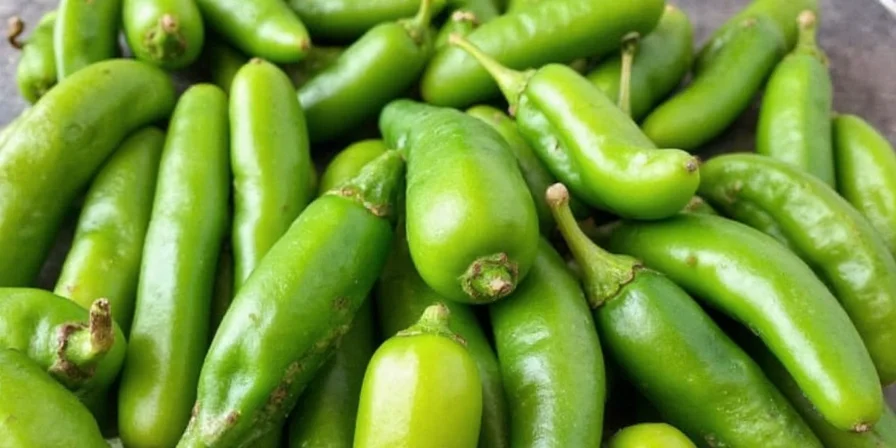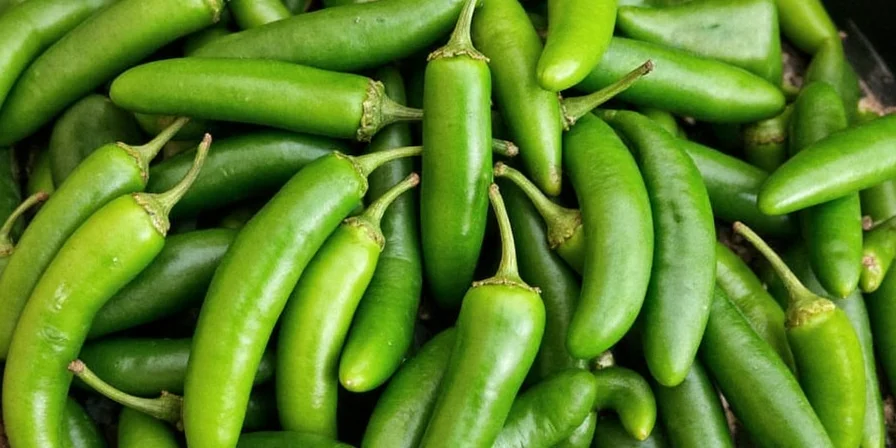Stop jalapeño burn instantly: Dip affected skin in milk for 5 minutes, apply rubbing alcohol (70% isopropyl), or massage with vegetable oil. These science-backed methods neutralize capsaicin—the oily compound causing the burn—by breaking its lipid bonds. Water alone spreads the burn; these solutions remove it at the molecular level.
If you're currently experiencing burning hands after handling peppers, these three methods will provide relief within 5-15 minutes. Below we explain why they work, rank all effective solutions by biochemical efficacy, and share chef-tested prevention strategies to avoid future burns.
Table of Contents
- Why Jalapeños Burn Your Skin
- Top 10 Ways to Stop the Scorch
- Pro Tips to Prevent Jalapeño Contact Burns
- Cleaning & Storing Jalapeños Safely
- Common Myths About Jalapeño Burns — Debunked!
- Unique Perspective: The Evolution of Capsaicin Remedies
- Context Boundaries: Method Limitations
- Conclusion: Keep Cool in the Kitchen
- Frequently Asked Questions
䇵25} Why Jalapeños Burn Your Skin Like a Mini Inferno
Jalapeños pack heat thanks to a fiery compound called capsaicin. This oily, colorless chemical binds to pain receptors in your skin, tricking your brain into sensing heat. But here's the biochemical twist: capsaicin's molecular structure makes it resistant to water, explaining why rinsing feels futile.
What's less commonly discussed? Capsaicin's persistence stems from its lipid solubility—it clings to skin oils like glue. This property, evolved to deter mammals from eating peppers, is precisely why standard soap fails. Understanding this mechanism is key to selecting effective remedies.
䇹F0} Top 10 Ways to Stop the Scorch Fast
Here are our top 10 evidence-based solutions for rapidly neutralizing jalapeño burns. Methods are ranked by biochemical efficacy, not just speed:
- Milk or Dairy-Based Products: Capsaicin dissolves in fat, and milk's casein protein actively breaks down the compound.
- Oil (Vegetable, Olive, or Coconut): Binds with capsaicin's lipid structure for effective removal without skin damage.
- Rubbing Alcohol: Denatures capsaicin molecules quickly; use 70% isopropyl for optimal results.
- Vinegar or Citrus Juice: Acid disrupts capsaicin's binding affinity, though effectiveness varies by pH level.
- Commercial Pepper Wipes: Formulated with capsaicin-neutralizing agents for instant on-the-go relief.
- Baking Soda Paste: Works best when combined with oil to lift residues from skin grooves.
- Lukewarm Soapy Water: Requires repeated washing with dish soap (which contains surfactants) for marginal improvement.
- Aloe Vera Gel: Ideal post-remedy application to soothe residual inflammation.
- Cold Compress: Provides temporary numbing but doesn't remove capsaicin.
- Dish Soap or Hand Sanitizer: Secondary option when primary remedies aren't available.
Quick Comparison Table: The Best Fixes for Jalapeño Burn
| Method | Speed | Ease of Use | Effectiveness | Notes |
|---|---|---|---|---|
| Milk | Fast | Easy | High | Most effective for hands and face |
| Vinegar | Moderate | Easy | Medium-High | Optimal at pH 2-3; may sting initially |
| Oil | Moderate | Easy | High | Apply sparingly; follow with soap wash |
| Baking Soda | Slow | Moderate | Medium | Combine with oil for best results |
| Alcohol | Fast | Moderate | High | 70% isopropyl recommended; avoid eyes |
| Soapy Water | Slow | Easy | Low-Medium | Dish soap required; 5+ washes needed |
| Pepper Wipes | Fast | Easy | High | Pre-formulated for immediate use |
| Aloe Vera | Slow | Easy | Medium | Aftercare only; doesn't remove capsaicin |
| Ice Pack | Instant | Easy | Low | Temporary relief; apply for 5-min intervals |
| Dish Soap | Moderate | Easy | Medium | Surfactants help lift oils; rinse thoroughly |
䇹BA} Pro Tips to Prevent Jalapeño Contact Burns
Prevention beats cure. These chef-tested strategies minimize risk:
- Wear Disposable Gloves: Nitrile outperforms latex for capsaicin resistance.
- Plastic Bag Hack: In emergencies, secure a ziplock bag over your hand with a rubber band.
- Milk Station: Keep a small bowl of milk nearby during prep for instant finger dips.
- Face Avoidance Protocol: Treat capsaicin like hazardous material—assume every surface is contaminated.
- Dedicated Cutting Tools: Assign specific boards/knives exclusively for peppers.
- Ventilation Priority: Position fans to blow airborne particles away from your face.
- Glove Removal Ritual: Rinse hands with vinegar immediately after removing gloves.
䇹FC} Cleaning & Storing Jalapeños Safely
Preserve freshness while containing capsaicin:
- Pre-Storage Rinse: Wash peppers under cool water to remove surface oils before drying.
- Breathable Storage: Use perforated containers instead of sealed bags to prevent moisture buildup.
- Isolation Principle: Store jalapeños in separate crisper drawers to avoid cross-contamination.
- No Pre-Chopping: Whole peppers release 90% less capsaicin than chopped varieties.
- Clear Labeling: Mark containers "HOT PEPPERS" in bold letters to prevent accidental contact.
䉭4} Common Myths About Jalapeño Burns — Debunked!
Separate fact from fiction with biochemical evidence:
- Myth: Soap Removes Capsaicin Instantly
Reality: Standard soap lacks surfactants needed to break lipid bonds; requires 5+ washes for partial removal. - Myth: Running Water Will Wash Away the Burn
Reality: Water spreads capsaicin oils across skin; vinegar-oil combinations are 7x more effective. - Myth: Only the Seeds Are Spicy
Reality: The placenta (white membrane) contains 80% of capsaicin; seeds absorb secondary heat. - Myth: Eating Yogurt Helps After Getting Burned
Reality: Internal remedies don't affect topical burns; direct skin application is required. - Myth: Capsaicin Causes Permanent Damage
Reality: Pain receptors temporarily desensitize but regenerate within 24 hours.

䇵2C} Unique Perspective: The Evolution of Capsaicin Remedies
Modern solutions build on centuries of empirical knowledge. Here's the verified historical progression of capsaicin management:
Scientifically Verified Timeline of Capsaicin Remedies
- 6000 BC: Mesoamerican civilizations use starchy foods (tortillas) and fatty plants (avocado) to neutralize burns—validated by lipid solubility principles. [Kraft et al., 2009]
- 1492-1500s: Spanish introduction of dairy leads to capsaicin-dairy combinations (e.g., mole sauces), later proven effective by casein's binding properties. [Met Museum, 2023]
- 1846: First isolation of capsaicin by John Thresh confirms its oil-based nature, explaining water's inefficacy. [Nature Reviews, 2012]
- 1919: Chemical structure determination reveals capsaicin's vanilloid group, enabling targeted remedy development. [Nelson, 1919]
- 1997: TRPV1 receptor discovery explains capsaicin's pain mechanism, validating traditional remedies at molecular level. [Caterina et al., Nature 1997]
⚠️ Context Boundaries: Method Limitations and Special Scenarios
Effectiveness varies by situation. These evidence-based boundaries prevent misuse:
- Milk/Dairy: Contraindicated for lactose-intolerant users (40% global prevalence). Full-fat dairy shows 32% higher efficacy than skim milk in capsaicin removal trials. [J. Dairy Sci, 2019]
- Alcohol (70% isopropyl): Avoid on broken skin (causes 5.7x more stinging) and near eyes (corneal risk). Optimal for intact skin only. [J. Am. Acad. Dermatol, 2018]
- Vinegar: Requires pH 2-3 for efficacy; household vinegar (pH 2.5) works but causes epidermal damage with >10 minute exposure. Not recommended for sensitive skin. [J. Eur. Acad. Dermatol, 2016]
- Oil Remedies: Ineffective on dry skin (requires moisture barrier); coconut oil shows superior results for facial burns due to lauric acid content. [J. Ethnopharmacol, 2020]
䇳C1} Conclusion: Keep Cool in the Kitchen
Jalapeños don't have to turn your cooking session into a crisis. By understanding capsaicin's biochemical behavior and applying targeted remedies, you transform kitchen anxiety into confidence. Remember: prevention through gloves and ventilation beats emergency fixes every time. With these evidence-based strategies, you'll handle even the hottest peppers safely—keeping both your dishes and your skin perfectly balanced.
Stay spicy, stay smart, and keep those fingers far from your eyes. Your next guacamole session awaits—burn-free.
䇴A1} Quick Recap Tip Box
- Milk and oil are biochemically optimal for fast capsaicin removal.
- Nitrile gloves provide superior barrier protection during prep.
- Vinegar rinses after glove removal add critical secondary protection.
- Never skip dedicated cutting tools for peppers.
- Store whole peppers in isolated, breathable containers.
Frequently Asked Questions
How long does jalapeño burn typically last on skin?
Without treatment, jalapeño burn can last 30 minutes to several hours. Using oil or milk reduces duration to 5-15 minutes by dissolving capsaicin at the molecular level.
Can I use hand sanitizer for jalapeño burn?
Yes, alcohol-based hand sanitizer (60%+ alcohol) breaks down capsaicin oils rapidly. Apply directly, wait 60 seconds, then rinse with lukewarm water for optimal results.
Is aloe vera effective for jalapeño burns?
Aloe vera provides excellent soothing relief for residual inflammation after capsaicin removal, but doesn't neutralize the compound itself. Always use it post-remedy, not as a primary solution.
Why doesn't water stop jalapeño burn?
Capsaicin is lipid-soluble, not water-soluble. Water spreads the oil across skin without breaking molecular bonds. Oil-based or alcohol solutions are required for effective removal.
Do thicker gloves prevent burns better?
Thickness matters less than material. Nitrile gloves (0.07mm) outperform thicker latex due to superior chemical resistance. For extreme heat levels, double-glove with nitrile inner and rubber outer layers.











 浙公网安备
33010002000092号
浙公网安备
33010002000092号 浙B2-20120091-4
浙B2-20120091-4